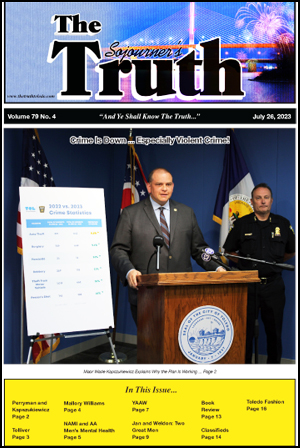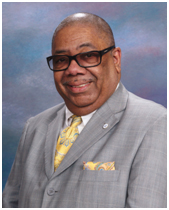
By Rev. Donald L. Perryman, Ph.D.
The Truth Contributor
The goal is to turn data into information and information into insight.
– Carly Fiorina
The latest crime statistics declare that the Kapszukiewicz administration has taken a large bite out of crime thus far in 2023.
Crime reduction was central to a divisive 2021 Kapszukiewicz vs. Finkbeiner mayoral contest. Moreover, crime remains a controversial policy issue today due to the complexity of its causes, effects and potential solutions. In addition, the intersection of various political, economic and social factors makes crime a difficult problem to disentangle completely.
I spoke with Mayor Wade Kapszukiewicz to understand the implications of the highly publicized downward trend in Toledo’s crime rates.
In our following conversation, Kapszukiewicz discusses how he “trusted the process” or utilized the power of persistence and did not allow himself to get sidetracked by disapproval, distractions or defiance in his successful quest to curtail crime.
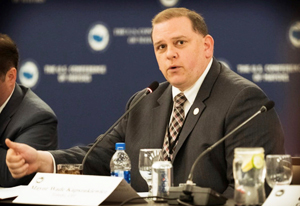
Perryman: Violent crime can have a profound impact, not just on victims and their families, but also on communities and our city as a whole. What are the results of your most recent crime statistics?
Mayor: What’s so notable is that it isn’t just one statistic; it is virtually all statistics, except for auto thefts which are up just a little bit for the first half of 2023. Every other measure of crime is down, and in most cases, it’s significantly down. When you look at the data, you’ll see across-the-board double-digit reductions in burglaries, shootings and homicides; that shows that we’re making real progress and turning the corner in addressing crime.
Perryman: During your 2021 mayoral campaign, you noted that crime rates were high everywhere as the rationale for Toledo’s high rates.
Mayor: Yes, and part of the story we also need to tell is that we’re doing so much better than the national average. So, while homicides are down 10 percent across the United States, they’re down almost 40 percent in Toledo. Seeing how much better we’re doing than the national average is incredibly encouraging. I might point out that cities are still struggling and trending in the wrong direction. Cleveland, for instance, is having a tough time this year; their homicides are up 30 percent.
Perryman: What are you doing differently than before to reduce crime?
Mayor: One mistake people made over the last two or three years in talking about violent crime was believing that there was one simple cause and effect. As a result, they felt that there was one simple solution. That thinking was wrong from the beginning. There are multiple reasons that violent crime went up across America beginning about three years ago, and likewise, to answer your question, there are numerous reasons here in Toledo; I think there are also multiple reasons it’s now going down.
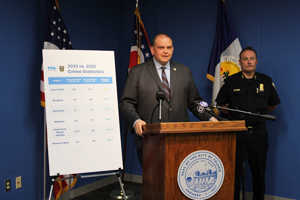
Perryman: Can you describe specifically what has led to the encouraging downward trend in crime?
Mayor: What happened in Toledo, in my judgment, is that we adopted a plan. We were disciplined enough to stick to our plan even when voices from the sidelines were trying to distract us from what was working. So, we followed a plan we adopted last December, and even in the face of political distraction and grandstanding, we were disciplined enough to stick to it. Thank goodness, because the plan is working, and what we need to do right now is follow it and not be distracted by any outside noise.
Perryman: What elements are a part of the plan?
Mayor: It’s a plan that involves a lot of things. It did involve a policing aspect. We thought it was essential to get more officers out on the streets, out of their cars, walking, and so we’ve done that. However, it also involved fighting blight and cleaning up abandoned tires and debris in neighborhoods.
The plan also involved programs for youth. I think everyone who’s heard me talk recently about the $4 million we spent on youth programming over the last two years and the 200 free youth programs we offer. It involved interruption, what we’re calling MONSE, the Mayor’s Office of Neighborhood Safety and Engagement, Malcolm and his team, the violence interrupters, making the long-term investments in the neighborhoods and healthcare, all of those things. That was all part of the plan that we adopted, and I think all of those things, taken as a whole, are why we are seeing these encouraging numbers. As encouraging as they are, though, we’re not satisfied, we’re not done. Still, I think it’s clear now that the plan we adopted is working, and what we need to do right now is not veer from it, not be distracted, and stick to what’s working.
Perryman: As you know, just because two or more events occur together doesn’t necessarily mean that one directly causes the other to happen. How can we avoid making hasty conclusions about cause-and-effect relationships based on the existence of a possible coincidence? How can we determine which elements of your plan are more effective or useful?
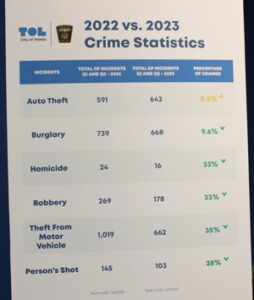 Mayor: That’s a great question and one that I’ve put a lot of thought to. At the end of the day, though, and maybe this will feel really simplistic, numbers don’t lie. The old expression is numbers don’t lie, but liars sure know how to use numbers. When you look at the data, there is no question that fewer people are being shot, fewer people are being killed, and fewer people are being robbed. There are 400 fewer crimes of all kinds across the board. Those numbers are genuine and significant, and I think they argue for us maintaining our plan.
Mayor: That’s a great question and one that I’ve put a lot of thought to. At the end of the day, though, and maybe this will feel really simplistic, numbers don’t lie. The old expression is numbers don’t lie, but liars sure know how to use numbers. When you look at the data, there is no question that fewer people are being shot, fewer people are being killed, and fewer people are being robbed. There are 400 fewer crimes of all kinds across the board. Those numbers are genuine and significant, and I think they argue for us maintaining our plan.
Yet, your point is correct. Maybe what’s happening is a recalibration of societal norms post-pandemic, which has nothing to do with officers walking or violence interrupters.
Perryman: You suggest that policing and prevention are complementary solutions rather than alternatives. Yet, fiscal hawks may oppose the $4 million spent on youth programming or question the contract amount paid to an outside violence interventionist like Cities United. Research tells us that more police don’t necessarily lead to reduced crime. In contrast, we do know that more investments in the inner city such as social services or community centers improve crime outcomes. Do we really need Cities United?
Mayor: When it comes to our youth programming, we are measuring and finding that there has been greater participation among more individuals. Cities United has a number of specific deliverables and measurables that can be ascertained. Again, they work with 130 different cities, so there’s a blueprint we can follow and check our progress versus the progress made in Indianapolis or pick a random city. At the end of the day, everything seems to be working, and it would be surprising to me if, at this moment, when we’re seeing success, people would want to change course.
I guess the last thing I’ll say about Cities United is there has been a lot of discussion about Cities United, almost all of it political, just put forward by political actors who I think fundamentally care more about themselves than Toledo.
At the end of the day, though, let’s debate its merits. The contract we signed with Cities United was $180,000. It’s not an ongoing cost; it’s not a legacy cost; it’s a one-time, one-year contract. We hire consultants all the time. When we build a sewer, we hire consultants; when dealing with a challenging legal issue, we might hire outside counsel. It is a routine normal part of how the city government has worked for 200 years. It’s $180,000, that’s real, but our police budget is $96 million. The fact that there has been so much conversation about the $180,000 out of a budget of $96 million really tells you everything you need to know about the sincerity of some of the voices that have rallied against Cities United. It is 17/100 of one percent of what we’re doing.
Perryman: We know that within the past year, there has been a change in the chief of police. So, how much of the crime reduction is the result of just plain old good leadership?
Mayor: To a great degree, good leadership has made a difference, and I’m not critical of Chief Kral. On the other hand, this is a result-oriented business, and the results under Troendle’s leadership have been good. Chief Troendle has made some tactical decisions regarding deploying resources that appear to have made a difference. He has deployed resources differently, there’s a different attitude.
So, the tone Troendle sets, some of the policies, the deployment of resources, and the use of data again are strengths. Like former Chief Diggs, he believes in data-based policing and a real-time crime center.
Perryman: Are there other leaders who have contributed?
Mayor: When I talk about leadership, that also includes some folks within city hall, including the city council. There has been a false dichotomy of Carty [Finkbeiner] versus me or the former mayors versus me. Carty was taking just as many shots, in fact, making more shots at the city council than anyone else. The city council deserves some credit for staying strong, not being distracted by Carty’s silliness, and sticking to our plans. I think leadership across the board and steadiness across the board for the police chief, steadiness from the city council. Again, the discipline to stick to our plan even when an outside intruder is pushing their own agenda, trying to take you off the path, city council and the chief and others were smart enough and disciplined enough to stick with the plan.
Perryman: What is a blueprint to sustain your success?
Mayor: Now don’t get me wrong, Toledo is far from perfect, but we’re making real progress, and it’s essential for people to know that. If you’re constantly beaten down by negativity and defeatism, and wild hyperbole, I don’t think that’s positive for an individual, a family, or a city.
Again, the media has a fear industrial complex. They benefit when people are afraid. I think we have to continue to follow what we’re doing. The worst thing we could do right now is veer off the plan and make decisions based on political considerations; that’s the most important thing.
Perryman: When we’re talking about crime, the success of your interventions is reflected after the fact by lagging indicators. So, basically, you’re saying “Trust the Process.”
Mayor: Yes, I won’t be around to reap the benefits of the greater sense of economic fairness sprinkled throughout our city due to what we passed and implemented, but it’s part of it. In the classical sense, politicians are hesitant to do all these things because they rarely get credit for them.
These longer-term investments in neighborhoods that I believe will reduce crime might take a couple of years to really take hold. Just the nature of politics is that everyone has moved on and gotten elected or defeated.
So, they’re not there to benefit from things like the disparity study, the Wayman Palmer YMCA, or the many things we’ve done. It’s the nature of it, but again, I just want to continue to do work that I think will make a real difference for people; I’ll let the political consequences fall where they may.
Contact Rev. Donald Perryman, Ph.D. at drdlperryman@centerofhopebaptist.org

